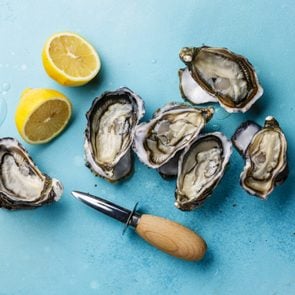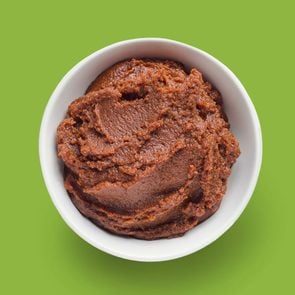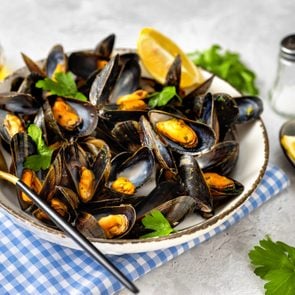This Is the Best Way to Eat Soup Dumplings, According to Pros
Updated: Jan. 30, 2024
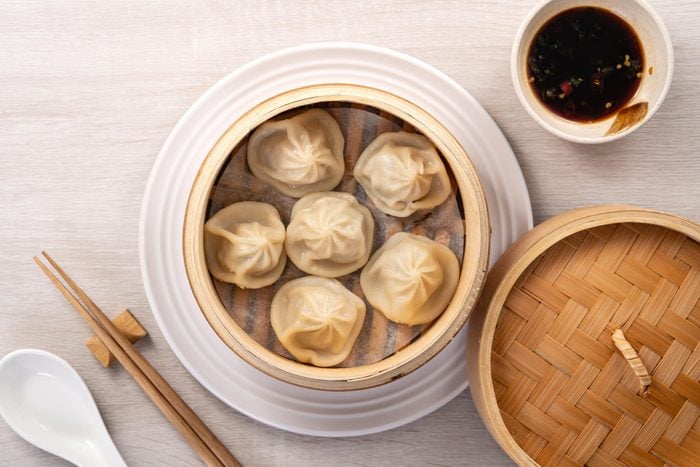
Avoid etiquette errors—and painful burns!—by learning how to eat soup dumplings before ordering your first batch
Nowadays, it seems like soup dumplings are everywhere. But when I first had them more than 15 years ago, they were a regional Shanghainese secret—one so special that my dad made me recite their name, xiao long bao, several times so that I could practice ordering them before I visited that city for the first time. He told me what to expect, how to eat soup dumplings (and how not to eat soup dumplings), proper etiquette and table manners for enjoying them, and probably most important, how to avoid burning myself or making a mess while eating these delicate and delicious thin-skinned purses of meat and broth.
I was lucky. Not everyone has Asian parents to teach them things like how to eat with chopsticks or how to eat sushi. And not everyone has a Chinese father to introduce them to the diverse, umami-rich world of dumplings—and show them how to best enjoy them.
Yet even with that cultural advantage, I still had questions. How do I know when a dumpling has hit that magic Goldilocks moment, no longer a burn risk but still warm enough that the fatty broth hasn’t congealed? Am I supposed to dip or douse them in sauce? How do I keep them from bursting unintentionally? And where on earth does the soup come from?
To find out these answers and the ultimate truth behind how to eat soup dumplings politely, respectfully and appreciatively, I turned to five soup-dumpling and Chinese-food experts—including the nation’s top names in at-home soup dumplings and Asian sauces. Here’s what they had to say.
Get Reader’s Digest’s Read Up newsletter for more food tips, humor, cleaning, travel, tech and fun facts all week long.
Why do people love soup dumplings so much?
First and foremost, soup dumplings are special. Candy Hom, chef and owner of acclaimed Atlanta-based pop-up Soupbelly, thinks that’s because “they are so difficult to execute and therefore not as commonly sold as other dumplings.”
For Anmao Sun, co-founder of San Francisco’s celebrated Mamahuhu restaurant, it’s a bit more personal. “It gives me Old Shanghai vibes and brings me back to my time there, among old lane houses and riding a scooter down tree-lined streets at twilight,” he says.
Brian Yong, culinary director of Seattle-based MìLà, a driving force behind home-steamed soup dumplings, put it most poetically: “They have the idiosyncratic quality of being elegant and refined but also rustic and comforting,” he says. “At its core are humble, familiar ingredients: wheat, water and meat. But through ingenuity and craftsmanship, they’re transformed into a unique sensory experience.”
What are soup dumplings?
Are you imagining a traditional winter soup? Don’t. Soup dumplings are a different food altogether.
While the central filling can vary, soup dumplings are typically bite-sized bundles of pork-based meat wrapped in a highly elastic but delicately thin-skinned dough. “The term soup dumpling typically refers to a dumpling whose filling has been augmented with aspic, or a gelatinized liquid, which then releases a savory broth upon its cooking,” says Yong. The melting of this gelatinized broth is what creates the little pool of “soup” the meat in the middle sits in, infusing its own mixture’s flavor into the soup in turn.
These days, you’ll find soup dumplings in a variety of forms. Many are tiny and cute, but some measure the size of your face. You can order soup dumplings with a range of fillings, from pork or crab to limited-edition Taiwanese beef broth. Pro tip: “The ones with hairy crab are the best,” Sun says enthusiastically.
In the United States, you’ll even find twists on the classic. “Xiao long bao has become synonymous with the term [soup dumpling], but there are others, such as sheng jian bao and tang bao, which fit the definition,” says Yong. That’s a fun food fact to keep in your back pocket for trivia night.
How to eat soup dumplings
Just as you need a little guidance on how to eat lobster before trying the crustacean for the first time, you need to understand how to eat soup dumplings before popping one of these bite-sized morsels into your mouth. For starters, know that they arrive at the table piping hot and are fit to scorch your mouth should you rush the process. And that’s only the tip of the iceberg.
1. Assemble your utensils
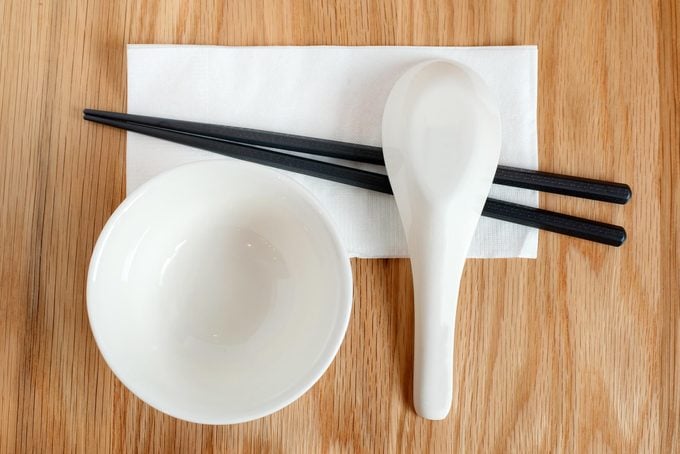
A Chinese-style soup spoon is integral to enjoying soup dumplings, as its oversized basin captures overflow, and its flat bottom allows you to rest it on your plate or table. Grab a good pair of Chinese chopsticks (which differ from Japanese and Korean chopsticks in their blunter ends and length) and a small dish for dipping sauce.
If you’re eating soup dumplings out, the restaurant will likely set the table with all your necessary utensils.
2. Mix your dipping sauce
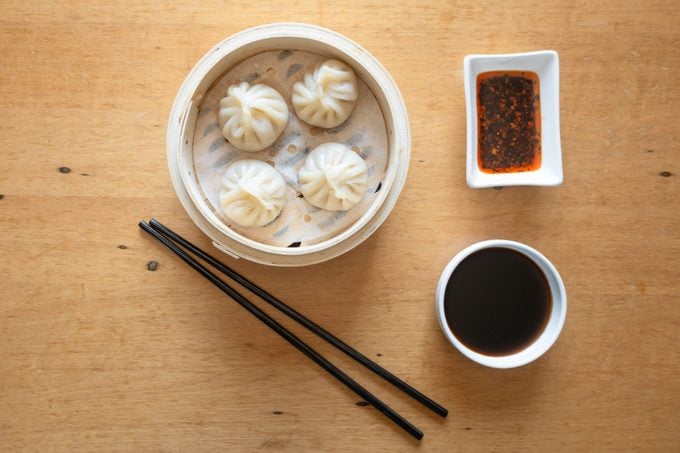
Chinese black vinegar with fresh julienned ginger is a common simple sauce favored for soup dumplings. “Marinate thinly sliced ginger threads in the vinegar, then place them on the dumplings before eating,” says Chris Kimura, a corporate chef for Lee Kum Kee, the global leader of Asian sauces. “This keeps the vinegar from being diluted as you eat.”
As for the vinegar itself, fellow Lee Kum Kee corporate chef Fred Wang explains that there are several kinds of Chinese black vinegar. “Zhenjiang vinegar and Shanxi vinegar are the major types. The flavor difference comes from the key ingredient used in each—fermented rice for Zhenjiang and sorghum for Shanxi, which gives it a stronger sourness, and alcohol from fermentation.”
Kimura adds that red vinegar, made with red yeast and “lighter in flavor complexity, with a cleaner acid flavor and light sweetness,” is also commonly found in Chinese dumpling culture.
Go with what you enjoy, but if you’re aiming for authenticity, you’ll want to stick with black vinegar. “If you order xiao long bao in Southern China [where they originated], they typically serve it with Zhenjiang vinegar,” Wang notes.
That’s what Yong suggests for his brand’s soup dumplings. Hom and Kimura also prefer this type, which they refer to by its other name, Chinkiang vinegar. “It’s rich with umami and contains hints of malt while packing a lighter acidic punch than typical white vinegar,” Kimura says.
Personally, I won’t use anything but Shanxi, and lots of it! As Kimura aptly describes, “It’s robust, earthy and smoky with less sweetness and acidity than Chinkiang.”
3. Remove the dumpling from the steamer
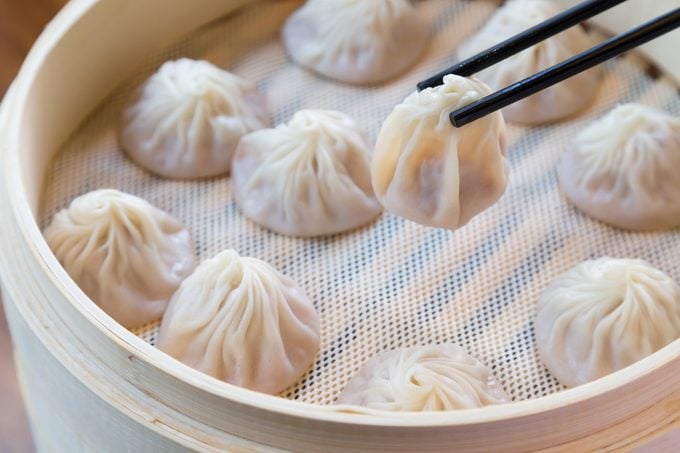
Some restaurants provide tongs, while others have diners rely on their chopsticks for serving. Either way, the polite way to eat soup dumplings is one at a time … and carefully! “The skin is very thin,” Kimura warns, “so it should be gently picked up from the top knot and placed in a soup spoon.”
I know they smell amazing, but avoid the urge to rush the process. “When you pinch the top with chopsticks, do it slowly to prevent it from tearing, as it may stick to the steamer basket liner or to another dumpling,” Hom advises.
4. Nibble to release the soup, then drink it up
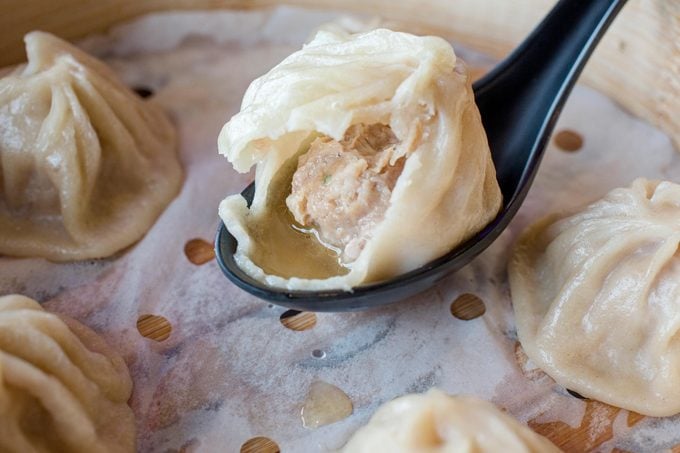
Other than accidentally tearing the dumpling and losing all the soup, the other common—and dangerous!—rookie mistake is to pop it in your mouth whole and right away. “It’s an understandable but avoidable recipe for disaster,” Yong says.
This isn’t a simple etiquette mistake. This is a mishap that could lead to a serious mouth burn, Sun attests. But don’t worry. The pros are here to teach you how to eat soup dumplings without scorching yourself.
Kimura suggests starting by tilting it away from you. “Then bite the top of the dumpling to create a hole to release the steam,” says Hom. “Wait as long as you can before slurping the soup.”
Yong puts three minutes as the ideal time to wait before going for it, but Sun goes in after five seconds. Hom meets them in the middle by blowing on it “until it doesn’t look like you just opened a [hamman] door!”
Alternatively, Yong suggests that instead of sucking the soup out of the dumpling, you can bite the side to release the broth into the soup spoon, allowing it to cool as it pools and comes into contact with the air. Just be mindful if you do. “You definitely don’t want to lose all that juice,” Sun says. That would defeat the entire purpose of this type of dumpling.
5. Dip the dumpling and finish eating it
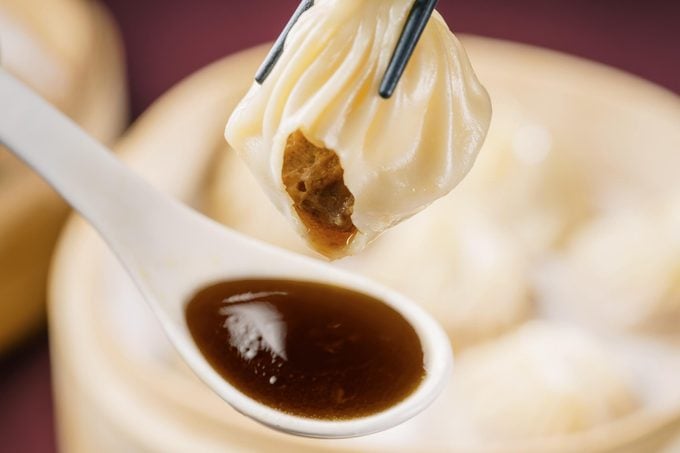
With the soup drained and enjoyed, the rest of the dumpling—the remaining skin and the entire filling—is now ready to be enjoyed with your dipping sauce. With this step, try to go for what Sun calls a light dip. “Don’t drench it or let it sit in the sauce,” he says. That can overwhelm the filling’s flavors or affect the texture of the dumpling skin.
As for the process, “there are a few schools of thought for dipping etiquette,” Yong says. “I prefer to enjoy the soup’s natural flavor first, then dip the skin and filling into diluted vinegar. Some folks pour the vinegar on top of their dumplings, others into their spoon to drink with the last of their soup.”
Hom acknowledges the myriad ways people use the sauce but has her own go-to process. “I know some people like pouring the sauce into the hole they made biting the top of the dumpling, but I feel you can’t appreciate the delicate flavors that way,” she says. “So I use the sauce and remainder of the dumpling as a last bite/palate cleanser before the next soup dumpling.”
But the way she sees it, “as long as everyone can find a way to enjoy them without losing all the soup, it’s still successful!”
FAQs about eating soup dumplings
Other than the safety factors, there aren’t a lot of hard-and-fast rules around eating soup dumplings. Because they’re considered comfort food—despite the immense skill and effort required to make them from scratch—there aren’t a lot of etiquette guidelines specific to the dumplings. The downside of this much flexibility is that it opens a first-time experience up to a lot of questions … all of which our pros were happy to answer.
Are there any serving etiquette rules?
Chinese meals are most often eaten family-style, with one serving dish shared among many. Rather than loading up your plate with your portion, it’s more polite to take one dumpling from the communal steamer and follow the steps to eating that one before grabbing another. In other words, don’t load your plate with your portion.
There’s an expectation that if you touch it (with tongs or your chopsticks), you take it. Don’t poke or pull at other dumplings to see which are firmer or easier to remove, and don’t serve others with your personal chopsticks.
Also, do not wait before grabbing your first dumpling. “A greater crime than eating a hot soup dumpling whole would be to let them get cold,” Yong says. “Soup dumplings are meant to be served piping hot!”
Hom agrees. “Waiting too long for them to cool can also cause the soup to absorb into the skin, making it dry on the inside,” she says. What’s more, if the soup cools overmuch, it may congeal.
Are there any dipping etiquette rules?
Per Chinese custom, most dumpling shops and Chinese restaurants provide each diner with their own sauce dish, as double-dipping in a shared sauce is considered universally unhygienic. But it’s the diner’s choice whether to dip directly into their sauce dish, to pour sauce over the dumpling resting in the soup spoon or to fill the spoon with sauce, then place the dumpling in it to gulp whole after they’ve drained the sauce.
Regardless, for freshly made soup dumplings, “‘bite and slurp first’ would be a proper way to eat the dumplings, as these provide more juice, and you want to savor it,” Wang says. “Otherwise, for general dumplings, ‘dip and eat’ would be OK.”
Do you eat soup dumplings in soup?
Unless you’re trying to be annoying to the dumpling maker, the answer to this question is a unanimous, resounding and unequivocal “no.”
“That’s a hat-on-hat situation,” Yong explains. “If you’re looking for interesting dumplings in soup, check out bubble wontons,” he suggests—but leave the xiao long bao out of the equation!
As Hom puts it, “anyone can put any random dumpling into soup. Putting soup into the dumpling itself requires a lot more skill. And that skill would be buried if it was served in soup.”
How do you eat soup dumplings without a spoon?
Carefully! “If you bite the top off with precision, all the soup in the dumpling should stay in the dumpling,” Sun says. But this requires holding the dumpling up with the chopsticks as the soup sags in the wrapper and its weight threatens to burst through, which adds stress and reduces enjoyment.
If you don’t have a Chinese soup spoon, grab a regular, wide-bowled soup spoon. Yong and Sun agree that this is significantly better than nothing. If you don’t have access to any kind of spoon, Hom says you may “lift the soup dumpling over an empty teacup or bowl, bite a hole on the side, and pour the soup into it. Eat the dumpling after it’s cooled down and sip the soup out of the bowl or cup.”
How do you eat soup dumplings if you don’t have chopsticks?
“A carefully aimed fork can lift the dumpling from the top without puncturing the sides,” Yong says. “Clean hands work as well. In the absence of utensils, a little patience and your fingers will get the job done well.”
Hom dittos that, pointing out that “you don’t risk breaking it as you would using a fork.”
But Sun’s practical advice is my favorite answer: “You should buy a pair of chopsticks,” he says wryly … and he’s not wrong!
Do you eat soup dumplings with soy sauce?
Our experts are in universal agreement that the recommended sauce is a Chinese black vinegar with ginger. (Not to be confused with one of the other types of vinegar.)
“This can be another instance of personal preference,” Hom says. “Every restaurant makes their own version of a soup dumpling, and the filling could be more delicate, where you might want more sauce to accompany it, or more intense, meaning you don’t want or need any sauce.”
The flavor profile of your soup dumplings may affect your choice of sauce too. “One may find the sweetness of a Shanghai-style xiao long bao pairs quite well with vinegar, while a more savory version could support a combination that includes chili oil and soy,” says Yong.
While black vinegar is an “essential piece” for Sun, he says soy sauce is an important “supporting character.” It adds nuance to the vinegar dipping sauce, which Hom says “can add enough saltiness to accentuate the delicate flavors of the soup and fillings.”
Still, she agrees with Sun, who says, “But I never want to dip my soup dumplings in pure soy sauce—that’d be no good!”
The simplest advice for finding the right sauce for you comes from Yong: “Try the soup dumplings by themselves first, then adjust to your liking!”
Why is vinegar the recommended dipping sauce base?
“The acid from the vinegar, mixed with the aromatics from the ginger, helps to balance the rich fattiness from the dumpling,” Kimura says.
Notice that saltiness doesn’t factor into the equation. And that’s for a reason: “You want to avoid any salty dipping sauce, since it may become excessively salty,” Wang adds. (Hence the light touch you’ll need when adding soy sauce to the mix.)
That doesn’t mean you can’t have a little fun beyond the various types of Chinese black vinegar. “For those who like a little extra spice, you can also add chili sauce or Chili Crisp Oil, preferably Lee Kum Kee, to turn up the heat,” says Kimura. Soupbelly and MìLà both have their own chili oil recipes, which they sell with their soup dumplings.
Is it rude to slurp while eating soup dumplings?
Hom got a laugh out of this question. “I think it’s pretty hard to hold back from slurping when eating a soup dumpling! Most of the guidelines are how to successfully enjoy the soup and not really guidelines on manners. So I support the slurp!”
If you’re concerned about following the most polite habit, you may want to adopt Sun’s view. “I subscribe to the Japanese ramen-eating tradition on this: The louder the slurp, the bigger the compliment,” he says.
Besides, slurping is part of Chinese food history. As Grace Lin writes in her forthcoming children’s book, Chinese Menu: The History, Myths, and Legends Behind Your Favorite Foods, “slurping was common because it cooled the noodles or dumplings as you ate, and waiting for the broth to cool might make those elements soggy and less enjoyable. Also, slurping tended to enhance the taste of the soup, bringing out the more subtle flavors.”
Yong’s reply is a simple shrug. “Slurping as etiquette is based.” (That’s internet slang for: He’s totally on board.) So do what feels right and natural—slurp up every last drop, with no need for apologies!
About the experts
- Candy Hom is the chef and owner of Atlanta handcrafted Chinese dumpling pop-up Soupbelly, which offers hand-ground and -wrapped dumplings in traditional and modern flavors. Soupbelly’s preorders often sell out in hours, and they’re often listed among the best dumplings in Atlanta.
- Chris Kimura is Professional Culinary Institute–trained chef who has worked alongside acclaimed chefs in fine-dining kitchens throughout San Francisco. Now, as a corporate chef for Lee Kum Kee, the leading maker of authentic Asian sauces and condiments for over a century, he uses his skills to help the global brand develop recipes.
- Anmao Sun is the co-founder of Mamahuhu in San Francisco, which has been heavily featured for its modern take on Chinese-American classics. Before launching Mamahuhu, he founded Hunter Gatherer, Shanghai’s first organic restaurant and grocery brand intentionally built around a transparent supply chain.
- Fred Wang is a corporate chef for Lee Kum Kee‘s recipe and new product development efforts. He brings more than 40 years of culinary experience to this 135-year-old Asian brand, starting in Shandong before immigrating to the United States more than 25 years ago to earn additional culinary degrees with bakery and pastry specialties in Los Angeles.
- Brian Yong is the culinary director of MìLà, the Seattle-based direct-to-consumer xiao long bao and Chinese street food brand responsible for bringing this beloved Shanghai snack to home kitchens across America. His exacting, scientific approach to creating soup dumplings is well documented in his blog series for the brand, No Ordinary Dumpling.
Source:

